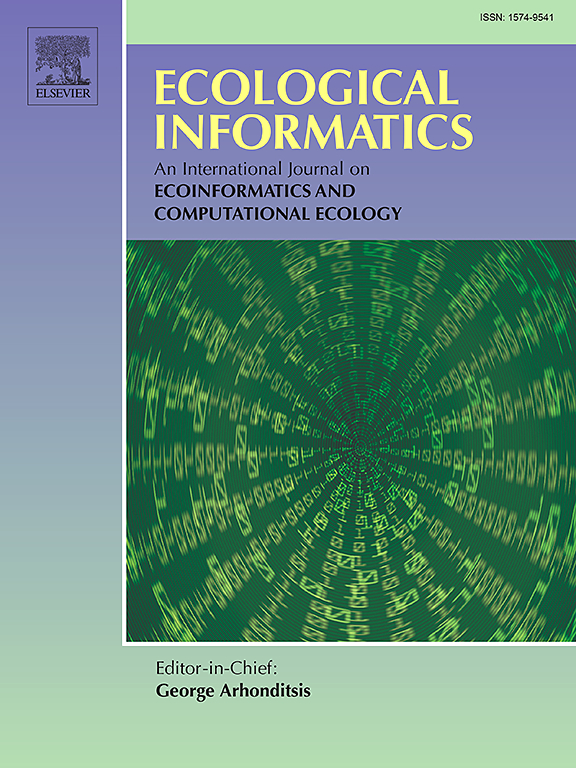SeagrassFinder: Deep learning for eelgrass detection and coverage estimation in the wild
IF 7.3
2区 环境科学与生态学
Q1 ECOLOGY
引用次数: 0
Abstract
Seagrass meadows play a crucial role in marine ecosystems, providing benefits such as carbon sequestration, water quality improvement, and habitat provision. Monitoring the distribution and abundance of seagrass is essential for environmental impact assessments and conservation efforts. However, the current manual methods of analyzing underwater video data to assess seagrass coverage are time-consuming and subjective. This work explores the use of deep learning models to automate the process of seagrass detection and coverage estimation from underwater video data. We create a new dataset of over 8,300 annotated underwater images, and subsequently evaluate several deep learning architectures, including ResNet, InceptionNetV3, DenseNet, and Vision Transformer for the task of binary classification on the presence and absence of seagrass by transfer learning. The results demonstrate that deep learning models, particularly Vision Transformers, can achieve high performance in predicting eelgrass presence, with AUROC scores exceeding 0.95 on the final test dataset. The application of underwater image enhancement further improved the models’ prediction capabilities. Furthermore, we introduce a novel approach for estimating seagrass coverage from video data, showing promising preliminary results that align with expert manual labels, and indicating potential for consistent and scalable monitoring. The proposed methodology allows for the efficient processing of large volumes of video data, enabling the acquisition of much more detailed information on seagrass distributions in comparison to current manual methods. This information is crucial for environmental impact assessments and monitoring programs, as seagrasses are important indicators of coastal ecosystem health. This project demonstrates the value that deep learning can bring to the field of marine ecology and environmental monitoring.

SeagrassFinder:用于野外大叶藻检测和覆盖估计的深度学习
海草草甸在海洋生态系统中发挥着至关重要的作用,提供了诸如固碳、改善水质和提供栖息地等益处。监测海草的分布和丰富程度对环境影响评估和保护工作至关重要。然而,目前人工分析水下视频数据评估海草覆盖率的方法耗时且主观。这项工作探索了使用深度学习模型来自动化水下视频数据的海草检测和覆盖估计过程。我们创建了一个超过8300个带注释的水下图像的新数据集,随后评估了几种深度学习架构,包括ResNet, InceptionNetV3, DenseNet和Vision Transformer,通过迁移学习对海草的存在和不存在进行二元分类。结果表明,深度学习模型,特别是视觉变形器,可以在预测大叶藻存在方面取得高性能,最终测试数据集的AUROC分数超过0.95。水下图像增强的应用进一步提高了模型的预测能力。此外,我们介绍了一种从视频数据中估计海草覆盖范围的新方法,显示了与专家手动标签一致的有希望的初步结果,并表明了一致和可扩展监测的潜力。拟议的方法可以有效地处理大量视频数据,与目前的人工方法相比,可以获得关于海草分布的更详细的信息。这些信息对于环境影响评估和监测计划至关重要,因为海草是沿海生态系统健康的重要指标。这个项目展示了深度学习在海洋生态和环境监测领域的价值。
本文章由计算机程序翻译,如有差异,请以英文原文为准。
求助全文
约1分钟内获得全文
求助全文
来源期刊

Ecological Informatics
环境科学-生态学
CiteScore
8.30
自引率
11.80%
发文量
346
审稿时长
46 days
期刊介绍:
The journal Ecological Informatics is devoted to the publication of high quality, peer-reviewed articles on all aspects of computational ecology, data science and biogeography. The scope of the journal takes into account the data-intensive nature of ecology, the growing capacity of information technology to access, harness and leverage complex data as well as the critical need for informing sustainable management in view of global environmental and climate change.
The nature of the journal is interdisciplinary at the crossover between ecology and informatics. It focuses on novel concepts and techniques for image- and genome-based monitoring and interpretation, sensor- and multimedia-based data acquisition, internet-based data archiving and sharing, data assimilation, modelling and prediction of ecological data.
 求助内容:
求助内容: 应助结果提醒方式:
应助结果提醒方式:


